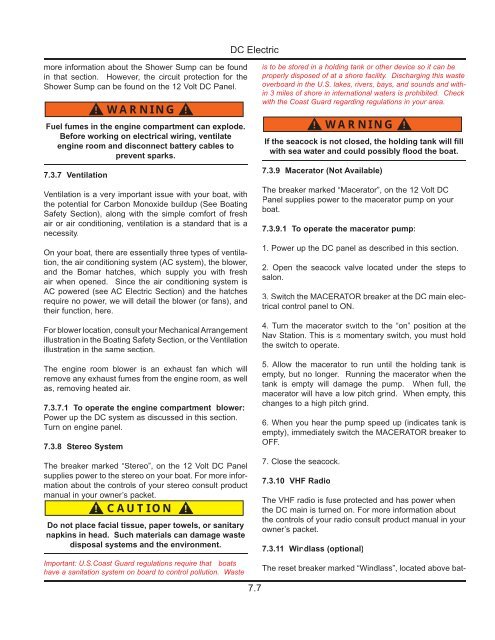36e Operator's Manual 2012.pdf - Marlow-Hunter, LLC
36e Operator's Manual 2012.pdf - Marlow-Hunter, LLC
36e Operator's Manual 2012.pdf - Marlow-Hunter, LLC
You also want an ePaper? Increase the reach of your titles
YUMPU automatically turns print PDFs into web optimized ePapers that Google loves.
more information about the Shower Sump can be found<br />
in that section. However, the circuit protection for the<br />
Shower Sump can be found on the 12 Volt DC Panel.<br />
! WARNING !<br />
Fuel fumes in the engine compartment can explode.<br />
Before working on electrical wiring, ventilate<br />
engine room and disconnect battery cables to<br />
prevent sparks.<br />
7.3.7 Ventilation<br />
Ventilation is a very important issue with your boat, with<br />
the potential for Carbon Monoxide buildup (See Boating<br />
Safety Section), along with the simple comfort of fresh<br />
air or air conditioning, ventilation is a standard that is a<br />
necessity.<br />
On your boat, there are essentially three types of ventilation,<br />
the air conditioning system (AC system), the blower,<br />
and the Bomar hatches, which supply you with fresh<br />
air when opened. Since the air conditioning system is<br />
AC powered (see AC Electric Section) and the hatches<br />
require no power, we will detail the blower (or fans), and<br />
their function, here.<br />
For blower location, consult your Mechanical Arrangement<br />
illustration in the Boating Safety Section, or the Ventilation<br />
illustration in the same section.<br />
The engine room blower is an exhaust fan which will<br />
remove any exhaust fumes from the engine room, as well<br />
as, removing heated air.<br />
7.3.7.1 To operate the engine compartment blower:<br />
Power up the DC system as discussed in this section.<br />
Turn on engine panel.<br />
7.3.8 Stereo System<br />
The breaker marked “Stereo”, on the 12 Volt DC Panel<br />
supplies power to the stereo on your boat. For more information<br />
about the controls of your stereo consult product<br />
manual in your owner’s packet.<br />
! CAUTION !<br />
Do not place facial tissue, paper towels, or sanitary<br />
napkins in head. Such materials can damage waste<br />
disposal systems and the environment.<br />
Important: U.S.Coast Guard regulations require that boats<br />
have a sanitation system on board to control pollution. Waste<br />
DC Electric<br />
7.7<br />
is to be stored in a holding tank or other device so it can be<br />
properly disposed of at a shore facility. Discharging this waste<br />
overboard in the U.S. lakes, rivers, bays, and sounds and within<br />
3 miles of shore in international waters is prohibited. Check<br />
with the Coast Guard regarding regulations in your area.<br />
! WARNING !<br />
If the seacock is not closed, the holding tank will fill<br />
with sea water and could possibly flood the boat.<br />
7.3.9 Macerator (Not Available)<br />
The breaker marked “Macerator”, on the 12 Volt DC<br />
Panel supplies power to the macerator pump on your<br />
boat.<br />
7.3.9.1 To operate the macerator pump:<br />
1. Power up the DC panel as described in this section.<br />
2. Open the seacock valve located under the steps to<br />
salon.<br />
3. Switch the MACERATOR breaker at the DC main electrical<br />
control panel to ON.<br />
4. Turn the macerator switch to the “on” position at the<br />
Nav Station. This is a momentary switch, you must hold<br />
the switch to operate.<br />
5. Allow the macerator to run until the holding tank is<br />
empty, but no longer. Running the macerator when the<br />
tank is empty will damage the pump. When full, the<br />
macerator will have a low pitch grind. When empty, this<br />
changes to a high pitch grind.<br />
6. When you hear the pump speed up (indicates tank is<br />
empty), immediately switch the MACERATOR breaker to<br />
OFF.<br />
7. Close the seacock.<br />
7.3.10 VHF Radio<br />
The VHF radio is fuse protected and has power when<br />
the DC main is turned on. For more information about<br />
the controls of your radio consult product manual in your<br />
owner’s packet.<br />
7.3.11 Windlass (optional)<br />
The reset breaker marked “Windlass”, located above bat-

















